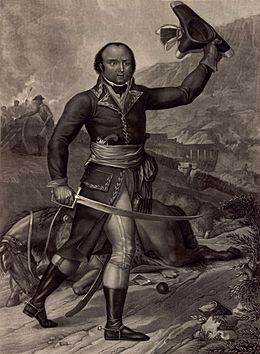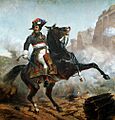Thomas-Alexandre Dumas facts for kids
Quick facts for kids
Thomas-Alexandre Dumas
|
|
|---|---|

Portrait by Guillaume Guillon-Lethière, c. 1797
|
|
| Birth name | Thomas-Alexandre Davy de la Pailleterie |
| Born | 25 March 1762 Jérémie, Saint-Domingue (today, Haiti) |
| Died | 26 February 1806 (aged 43) Villers-Cotterêts, France |
| Allegiance | |
| Service/ |
French Army French Revolutionary Army |
| Years of service | 1786–1801 |
| Rank | Divisional general |
| Commands held | Army of the Eastern Pyrenees Army of the Alps Army of the West Commander of Cavalry, Armée d'Orient (1798) |
| Battles/wars | French Revolutionary Wars War of the First Coalition War in the Vendée Italian campaigns of the French Revolutionary Wars Siege of Mantua (1796–1797) French Campaign in Egypt and Syria Battle of the Pyramids |
| Relations | Alexandre Dumas (son) Alexandre Dumas fils (grandson) Alexandre Lippmann (great-great-grandson) |
Thomas-Alexandre Dumas (born March 25, 1762 – died February 26, 1806) was a brave general from the French colony of Saint-Domingue (now Haiti). He served during the French Revolution. Dumas was special because he was a man of African descent who became a high-ranking general in a European army. He was the first person of color in the French military to reach the ranks of brigadier general, divisional general, and general-in-chief of a French army.
Dumas was born into slavery because his mother, Marie-Cessette Dumas, was of African descent and enslaved. His father, a French nobleman named Alexandre Antoine Davy de la Pailleterie, brought him to France in 1776. In France, slavery was against the law, so Dumas became free. His father made sure he received a good education and helped him join the French military.
Dumas played a huge role in the French Revolutionary Wars. He joined the army as a private soldier in 1786 when he was 24. By age 31, he was leading 53,000 troops as the General-in-Chief of the French Army of the Alps. His victory in opening the high Alpine passes in 1794 allowed France to start their Second Italian Campaign against the Austrian Empire. Austrian soldiers called him the Schwarzer Teufel ("Black Devil") because of his bravery. The French, including Napoleon Bonaparte, nicknamed him "the Horatius Cocles of the Tyrol" for his heroic actions at a bridge in March 1797.
Dumas also served in the French attempt to conquer Egypt from 1798 to 1801. He was the commander of the French cavalry. While there, he had disagreements with the expedition's leader, Napoleon Bonaparte. In 1799, Dumas left Egypt on a ship that was forced to land in the Kingdom of Naples, where he was taken prisoner. He was held in a dungeon until 1801.
After his release, he returned to France. He and his wife had a son, Alexandre Dumas (1802-1870), who grew up to become one of France's most famous writers. His son's well-known characters were often inspired by his father's adventures.
Contents
Early Life and Freedom
Thomas-Alexandre Dumas was born in 1762. His mother was Marie-Cessette Dumas, an enslaved woman. His father was a French nobleman. In 1776, when Dumas was 14, his father arranged for him to travel to France. Once in France, Dumas was freed because slavery was illegal there.
He lived with his father and received a good education. He learned fencing from the Chevalier de Saint-Georges, another mixed-race man from the French Caribbean. For many years, Dumas lived a comfortable life thanks to his father's wealth.
Joining the Army
In 1786, Dumas decided to join the French Army. Unlike other noblemen who became officers right away, Dumas enlisted as a private soldier. This was because French laws made it hard for mixed-race men to claim their noble titles. He joined the Queen's Dragoons and used his mother's name, "Alexandre Dumas." His father died soon after he joined.
Dumas's unit was in Paris during the French Revolution. They helped control crowds, including during the Champ de Mars Massacre in 1791. By 1792, Dumas was a corporal and saw his first combat. He captured 12 enemy soldiers while leading a small group of horsemen.
Rising Through the Ranks
Leading the Black Legion
In October 1792, Dumas became a lieutenant colonel in the Légion franche des Américains et du Midi. This group was also known as the "Black Legion" and was made up of free men of color. Dumas often led this legion. In April 1793, he helped defend the city of Lille from a coup attempt.
General of the Alps Army
Dumas quickly rose through the ranks. In July 1793, he became a brigadier general. A month later, he was promoted to general of division. In December 1793, Dumas was given command of the Army of the Alps. His mission was to defeat Austrian and Piedmontese troops defending the snowy Little Saint Bernard Pass.
In April and May 1794, Dumas launched several attacks. His army, using special ice crampons, climbed ice cliffs and captured many prisoners. This victory earned him praise from leaders in Paris.
Commander in Western France
From August to October 1794, Dumas led the Army of the West. His job was to bring order to the Vendée region, where there had been a large uprising against the French government. He focused on making sure his soldiers followed rules. One historian called Dumas "fearless and irreproachable" in this role.
Fighting in Italy
In November 1796, General Dumas joined the Army of Italy under Napoleon Bonaparte. Dumas disagreed with Napoleon's policy of allowing French troops to take property from local people.
The Siege of Mantua
In December 1796, Dumas was in charge of a group of soldiers surrounding Austrian troops in the city of Mantua. He stopped an Austrian attempt to break out of the city. This helped the French keep the city surrounded until more French soldiers arrived. Mantua surrendered in February 1797.
After this battle, Dumas felt insulted by a report about his actions. He was then given a smaller command. However, he continued to fight bravely. Austrian troops began calling him der schwarze Teufel ("Black Devil").
Hero of the Tyrol
In March 1797, Dumas led a small force that defeated Austrian troops at a bridge over the Eisack River. For this, the French called him "the Horatius Cocles of the Tyrol" (a hero who saved ancient Rome). Napoleon himself gave him this nickname and rewarded him with pistols.
Campaign in Egypt
In March 1798, Dumas was sent to Toulon, France, for a secret mission. He joined a large French fleet. In June, Napoleon announced their goal: to conquer Egypt. Dumas was made commander of all cavalry in the Army of the Orient.
In July, Dumas led his soldiers as the French conquered Alexandria. He then commanded the cavalry during the march from Alexandria to Cairo. The journey through the desert was very difficult due to heat and lack of supplies. Dumas and other generals complained about Napoleon's leadership.
Dumas fought in the Battle of the Pyramids and helped occupy Cairo. Napoleon learned about the generals' complaints and confronted Dumas. Dumas asked to return to France, and Napoleon allowed it.
However, the French fleet was destroyed by the British, so Dumas could not leave Egypt until March 1799. In October, he helped stop a revolt in Cairo by riding his horse into the Al-Azhar Mosque.
Imprisonment and Later Life
In March 1799, Dumas boarded a ship to return to France. The ship ran into storms and had to land in Taranto, in the Kingdom of Naples. Dumas and his companions were taken prisoner by a local army.
Dumas was held in a dungeon for two years. He was not given enough food and became very sick. He was partly paralyzed and almost blind in one eye. He believed he had been poisoned. His wife tried to get help from the French government, but it was difficult. Finally, in March 1801, French forces defeated the army holding him, and Dumas was released.
When he returned to France, Dumas was not given the pension that generals usually received. He struggled to support his family. He wrote to Napoleon asking for back-pay and a new military job, but he did not get much help.
Thomas-Alexandre Dumas died of stomach cancer on February 26, 1806. His son, Alexandre Dumas, was only three years old. His family faced poverty, and his wife had to work hard to support them.
Legacy and Honors
- Dumas's grandson, Alexandre Dumas fils, became a famous French playwright.
- General Dumas's name is carved on the south wall of the Arc de Triomphe in Paris.
- In 1913, a statue of General Dumas was put up in Paris. It stood for 30 years but was destroyed by the Germans in 1941–1942 during World War II.
- In 2009, a new sculpture honoring him was placed in Paris. It looks like broken slave shackles.
See also
 In Spanish: Thomas-Alexandre Dumas para niños
In Spanish: Thomas-Alexandre Dumas para niños
- Abram Petrovich Gannibal
- The Black Count: Glory, Revolution, Betrayal, and the Real Count of Monte Cristo
- Museum Alexandre Dumas
Images for kids



